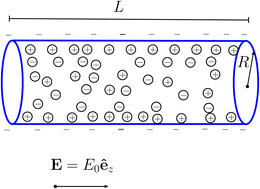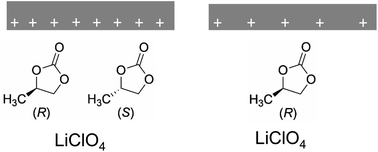Themed collection Iontronics: from fundamentals to ion-controlled devices

Poster list
Faraday Discuss., 2023,246, 623-624
https://doi.org/10.1039/D3FD90046K
List of participants
Faraday Discuss., 2023,246, 625-626
https://doi.org/10.1039/D3FD90045B
Preface: Iontronics: from fundamentals to ion-controlled devices
The Scientific Committee, from left to right: Professors Susan Perkin, Monica Olvera de la Cruz, Serge G. Lemay, René van Roij and Sanli Faez.

Faraday Discuss., 2023,246, 9-10
https://doi.org/10.1039/D3FD90050A
A screening of results on the decay length in concentrated electrolytes
We briefly review theoretical, experimental and simulation results on screening in concentrated electrolytes and study the effect of solvent and confinement on structure and screening behaviour using classical DFT combined with atomistic simulations.

Faraday Discuss., 2023,246, 520-539
https://doi.org/10.1039/D3FD00043E
Logic gating of low-abundance molecules using polyelectrolyte-based diodes
The electrical response and asymmetric ion transport affected the transport of low-abundance molecules across the diode. Integration of multiple diodes enabled implementation of an OR logic operation on both the voltage and the molecule transport.

Faraday Discuss., 2023,246, 141-156
https://doi.org/10.1039/D3FD00061C
Ionotronics for reverse actuation
Droplet spreading upon compression enlarges the contact area between the electrodes and electrolyte, increasing the double-layer capacitance, which generates a transient ionic current in solution and an electronic current in the circuit.

Faraday Discuss., 2023,246, 251-273
https://doi.org/10.1039/D3FD00056G
Concluding remarks: Iontronics, from fundamentals to ion-controlled devices – Random access memories
Is this the dawn of iontronics? Iontronics underpins the notion of devices and ionic machines, whereby ion and water also act as information carriers. Thinking about iontronics gives a vision and a road map, with applications in the water–energy nexus.

Faraday Discuss., 2023,246, 618-622
https://doi.org/10.1039/D3FD00138E
Evolution of the electrical double layer with electrolyte concentration probed by second harmonic scattering
We follow the evolution of the electrical double layer of colloidal SiO2 particles from the micromolar to the millimolar regime using nonlinear optical techniques and evidence a diffuse layer compression.

Faraday Discuss., 2023,246, 407-425
https://doi.org/10.1039/D3FD00036B
Unveiling the capabilities of bipolar conical channels in neuromorphic iontronics
We quantitatively explain the diodic and memristive properties of conical ion channels with bipolar surface charges. A modelled iontronic circuit of these channels exhibits neuronal spiking with membrane potentials comparable to mammalian values.

Faraday Discuss., 2023,246, 125-140
https://doi.org/10.1039/D3FD00022B
Unified quantum theory of electrochemical kinetics by coupled ion–electron transfer
A general theory of coupled ion–electron transfer (CIET) is presented, which unifies Marcus kinetics of electron transfer (ET) with Butler–Volmer kinetics of ion transfer (IT).

Faraday Discuss., 2023,246, 60-124
https://doi.org/10.1039/D3FD00108C
Ionic current driven by a viscosity gradient
This paper explores the dynamics of particles in a viscosity gradient with numerical simulations.

Faraday Discuss., 2023,246, 47-59
https://doi.org/10.1039/D3FD00053B
Spiers Memorial Lecture: Towards understanding of iontronic systems: electroosmotic flow of monovalent and divalent electrolyte through charged cylindrical nanopores
We present a classical density functional theory based on the hypernetted-chain approximation, which allows us to calculate the velocity of electroosmotic flows inside nanopores containing 1 : 1 or 2 : 1 electrolyte solution.

Faraday Discuss., 2023,246, 11-46
https://doi.org/10.1039/D3FD00062A
Nanofluidic diodes based on asymmetric bio-inspired surface coatings in straight glass nanochannels
Nanofluidic channels with a bio-inspired polydopamine and poly-L-lysine coating exhibit significant diodicity and are capable of exceeding 1000-fold current rectification under certain conditions.

Faraday Discuss., 2023,246, 356-369
https://doi.org/10.1039/D3FD00074E
Effect of ionic conductivity of electrolyte on printed planar and vertical organic electrochemical transistors
We investigated the impact of two semi-solid gel electrolytes, iongel and organogel, with different ionic conductivities on the performance of printed planar and vertical organic electrochemical transistors (OECTs).

Faraday Discuss., 2023,246, 540-555
https://doi.org/10.1039/D3FD00065F
Iontronic microscopy of a tungsten microelectrode: “seeing” ionic currents under an optical microscope
We apply EDL-modulation microscopy to one of the main components of amperometric measurement devices: a microelectrode.

Faraday Discuss., 2023,246, 426-440
https://doi.org/10.1039/D3FD00040K
Real-time visualisation of ion exchange in molecularly confined spaces where electric double layers overlap
We explore in real-time transport of ionic species (LiClO4) confined between a negatively charged mica and an electrochemically modulated gold surface using Surface Force Apparatus, molecular dynamics simulations and continuum-based Stern model.

Faraday Discuss., 2023,246, 487-507
https://doi.org/10.1039/D3FD00038A
Dielectric-free electrowetting on graphene
Electrowetting on graphene substrates is studied as a function of electrolyte identity and graphene layer number; the response observed is contrasted with that seen on the bulk material (graphite).

Faraday Discuss., 2023,246, 307-321
https://doi.org/10.1039/D3FD00037K
Gating ion and fluid transport with chiral solvent
Nonlinear spectroscopy and electrokinetic measurements reveal that the electrochemical properties of a solid–liquid interface in salt solutions in propylene carbonate are dependent on the solvent chirality.

Faraday Discuss., 2023,246, 508-519
https://doi.org/10.1039/D3FD00063J
Ion adsorption and hydration forces: a comparison of crystalline mica vs. amorphous silica surfaces
A systematic study using dynamic Atomic Force Microscopy of hydration forces on mica surfaces and amorphous silica surfaces in aqueous electrolytes containing chloride salts of various alkali and earth alkaline cations of variable concentrations.

Faraday Discuss., 2023,246, 274-295
https://doi.org/10.1039/D3FD00049D
Surface polarization enhances ionic transport and correlations in electrolyte solutions nanoconfined by conductors
Nanochannels made of conductors enhance ion transport due to the screening of electrostatic interactions by the induced polarization.

Faraday Discuss., 2023,246, 576-591
https://doi.org/10.1039/D3FD00028A
Disentangling 1/f noise from confined ion dynamics
1/f noise is intrinsic to ion transport; deviations to it allow probing of the dynamics of confined systems.

Faraday Discuss., 2023,246, 556-575
https://doi.org/10.1039/D3FD00035D
Iontronic memories based on ionic redox systems: operation protocols
A recently developed, new ionic device called the ionic voltage effect soft triode (IVEST) was optimized, tuned and embedded into a memory application concept.

Faraday Discuss., 2023,246, 296-306
https://doi.org/10.1039/D3FD00020F
Fuelling electrocatalysis at a single nanoparticle by ion flow in a nanoconfined electrolyte layer
Electrocatalysis at an isolated nanoparticle induces the growth of an electrolyte nanodroplet by ion pumping across a nanochannel.

Faraday Discuss., 2023,246, 441-465
https://doi.org/10.1039/D3FD00032J
Pulsed electrolysis – explained
Periodic dynamic operation promotes CO faradaic efficiency. The key promoting parameters are the charge transfer coefficients of parallel reactions.

Faraday Discuss., 2023,246, 179-197
https://doi.org/10.1039/D3FD00030C
Ionic fluctuations in finite volumes: fractional noise and hyperuniformity
Ionic fluctuations in finite observation volumes exhibit fractional noise features and hyperuniformity with time, improving our understanding of single-particle electrochemistry.

Faraday Discuss., 2023,246, 225-250
https://doi.org/10.1039/D3FD00031A
Structure and anomalous underscreening in ethylammonium nitrate solutions confined between two mica surfaces
We present direct measurements of the interaction force as a function of separation distance, measured using a surface force balance, across solutions of a protic ionic liquid ethylammonium nitrate and its mixtures with water.

Faraday Discuss., 2023,246, 370-386
https://doi.org/10.1039/D3FD00042G
Electrical noise in electrolytes: a theoretical perspective
We highlight the central role of the charge–charge dynamic structure factor in the fluctuations of electrical observables in electrolytes and offer a unifying perspective over a variety of complementary experiments.

Faraday Discuss., 2023,246, 198-224
https://doi.org/10.1039/D3FD00026E
Nanoscale probing of local dielectric changes at the interface between solids and aqueous saline solutions
A multifrequency approach based on high-resolution atomic force microscopy in liquid is developed to map the dielectric properties of solid–electrolyte interfaces with nanoscale resolution.

Faraday Discuss., 2023,246, 387-406
https://doi.org/10.1039/D3FD00021D
Iontronics under confinement: general discussion
Faraday Discuss., 2023,246, 592-617
https://doi.org/10.1039/D3FD90034G
Iontronic dynamics: general discussion
Faraday Discuss., 2023,246, 322-355
https://doi.org/10.1039/D3FD90032K
Iontronic coupling: general discussion
Faraday Discuss., 2023,246, 157-178
https://doi.org/10.1039/D3FD90031B
Iontronic microscopy: general discussion
Faraday Discuss., 2023,246, 466-486
https://doi.org/10.1039/D3FD90033A
About this collection
We are delighted to share with you a selection of the papers associated with a Faraday Discussion on Iontronics: from fundamentals to ion-controlled devices. More information about the related event may be found here: http://rsc.li/iontronics-fd2023. Additional articles will be added to the collection as they are published. The final versions of all the articles presented and a record of the discussions will be published after the event.
Studying interaction of solvated ions with interfaces and their transport inside ionic devices has been a recurrently hot topic for research at the interface of physics, chemistry, and processing technologies. Iontronics, in a general use of this term, concern systems in which dissolved ions such as Na+, Cl-, and Ca2+ get transported. The driving force in iontronics is not necessarily electric or diffusive, but sometimes also convective due to fluid flows. The coupling between charge and fluid transport has found a wide range of applications, from signal transduction to energy generation or storage. The breadth and diversity of iontronic concepts, however, has been studied in parallel scientific tracks. To create opportunities for cross-fertilization between these tracks, this Faraday Discussion will be an opportunity to present the most recent experimental, theoretical, and numerical methods in the field, to review some of the existing challenges, both in fundamental research and in industrial applications, and to strengthen synergetic interactions between researchers addressing the microscopic and device-level mechanisms involved in these very pressing problems. This meeting will cover 4 main themes: Iontronic coupling, Iontronic dynamics, Iontronics under confinement and Iontronic microscopy.
On behalf of the Scientific Committee, we hope you join us and participate in this exciting event, and that you enjoy these articles and the record of the discussion.